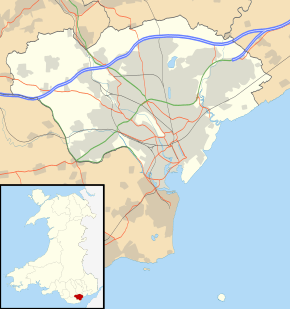Llanrumney Hall
Llanrumney Hall (Welsh: Neuadd Llanrhymnu) is Grade II* listed building in the Cardiff suburb of Llanrumney in Wales. The Elizabethan mansion was built in 1450, rebuilt in 1852 and refurbished around 1900. Throughout its history it has been a stately home and more recently a pub. The building had fallen into disrepair. New plans were brought up and a local businessman has taken over the renovation and repair work. The building has now been renovated and completed in 2019.
| Llanrumney Hall | |
|---|---|
Llanrumney Hall in 2014 | |
 Llanrumney Hall within the present day border of Cardiff | |
| Alternative names | Neuadd Llanrhymni |
| General information | |
| Type | Country house; former public house |
| Address | Ball Road, Llanrumney |
| Town or city | Cardiff |
| Country | Wales |
| Coordinates | 51°31′19.7″N 3°7′47.2″W |
| Construction started | 1450 |
| Owner | Cardiff Council |
History

The area of Llanrumney was given to the monks at Keynsham Abbey, in Somerset, England, after the Norman conquest of England. They built a small chapel on the site of what is now Llanrumney Hall.[1]
The Elizabethan Llanrumney Hall and its 700 acres (280 ha) estate was originally built in 1450 and is thought that it passed to the Kemys family of Cefn Mably in the mid-1500s after the dissolution of the Monasteries by Henry VIII.[1][2] William Kemys left the estate to his daughter, who was married to Thomas Morgan.[3] Llanrumney Hall has since been occupied by five generations of the Morgan family,[1] whose ancestral home was Tredegar House in Newport. Morgan Morgan was the last in the male line and the hall and estate passed by marriage onto the Lewis family in 1726.[2] In the mid 19th century, the hall was occupied by Edward Augustus Freeman, the Regius Professor of History at the University of Oxford.[2] It was purchased by Charles Crofts Williams of Roath Court in 1859,[2] who was the hall's last recorded Lord of the Manor.[1] Around 1900 the hall was refurbished.[1] His family lived at the hall until the development of the surrounding housing estate, when it was occupied by Llewellyn Williams.[2]
In 1952 the hall was compulsorily purchased by Cardiff Council and it became a remand centre.[2] By 1956 it became a pub, but the hall fell into disrepair by the late 1980s.[2][1] A plan has been developed by Cardiff Council and CMB Engineering to redevelop the hall into an education and sporting facility at a cost of about £1 million.[4] The Llanrumney Hall Community Trust Limited was established in January 2015 in the development of the building.
Listing status
Many sources list Llanrumney Hall either as a Grade I or Grade II listed building.[4][5] However the official listing by Cardiff Council shows Llanrumney Hall PH (Public House) as Grade II*, and that it was first listed on 19 May 1975.[6]
Myths and legends
Legend has it that the hall is haunted and many children will not go near it.[7] It is also believed that the hall contains a masonry block with the decapitated body of Llewellyn the Last. Stories also tell of how he was beheaded at the hall and chopped into small pieces and scattered around his house.[7]
A common local belief is that Sir Henry Morgan, after whom Captain Morgan rum is named, was born in the hall in 1635, but there is little evidence to substantiate this.[3][8][9][7][10] Morgan was born in Rhymney, near Tredegar, in the South Wales Valleys.[10]
See also
References
- "The Hall". Llanrumney Hall Community Trust Limited. Retrieved 2017-01-22.
- "Llanrumney Hall PH, Llanrumney". BritishListedBuildings.co.uk. Retrieved 2017-01-22.
- "The History of Cardiff's Suburbs – Llanrumney". Cardiffians (Matthew Witty). Retrieved 2016-11-06.
- "Historic Llanrumney Hall to get £1m facelift thanks to Cardiff City director's backing". Walesonline. 2015-10-07. Retrieved 2017-01-22.
- "The hidden history of Llanrumney". The Guardian. Retrieved 2017-01-22.
- "My House". City of Cardiff Council. Retrieved 2017-01-22.
- Llanrumney Hall, archived from the original on 2016-11-15, retrieved 2017-10-23
- "Llanrumney, City of Cardiff". Walesdirectory.co.uk. Retrieved 2017-01-23.
- "Spotlight: Captain Henry Morgan". Tumblr. Retrieved 2017-01-23.
- Harry Morgan's Way: The Biography of Sir Henry Morgan, 1635–84, Dudley Pope, Martin Secker & Warburg Ltd, (1977) ISBN 0-436-37735-7
External links
- Official website
